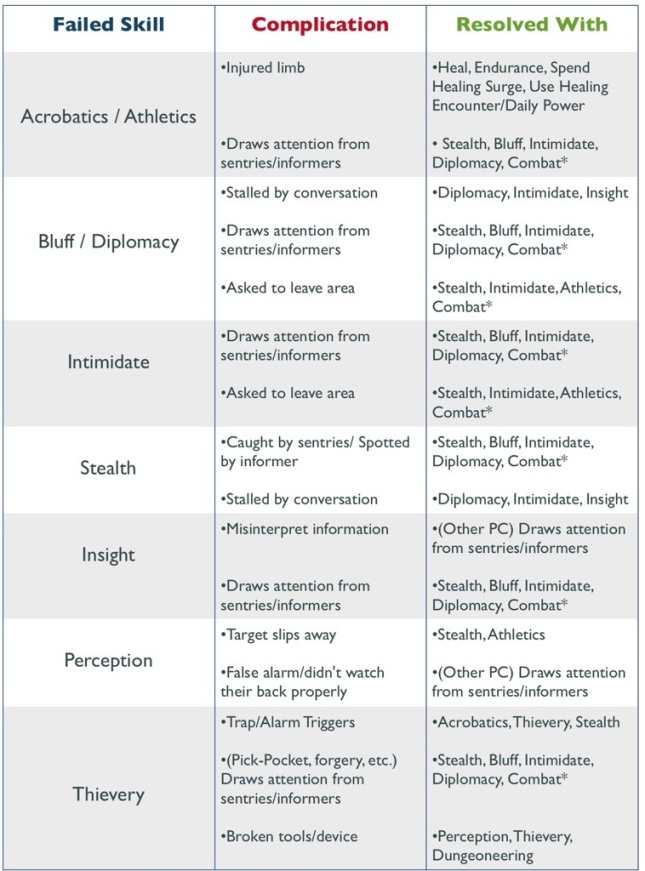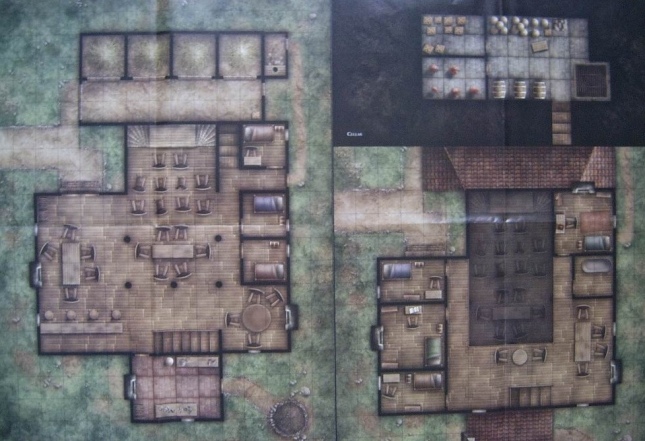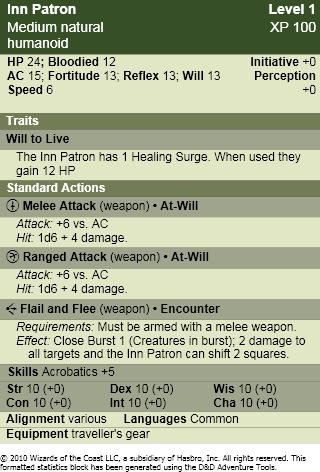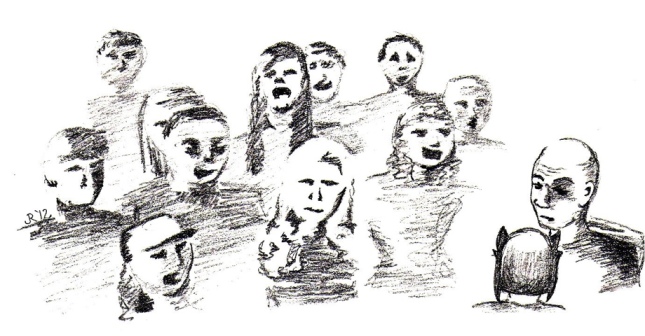This encounter is intended for three players of 2nd level and uses the August D&D Next Playtest Rules
One of the difficulties of living in a subterranean hell-hole like the Underdark, is that you cannot make/grow all the things you desire to use in your various plans and plots. Thus, trade with the surface world is inevitable. For the Drow and other Underdark dwellers, this means dealing with the disreputable and cruel elements that lurk topside. To facilitate this, trade posts are often established within a few miles of an access point to the surface. Though not truly in the Underdark due to their proximity to more typical caves and caverns, these establishments are just as dangerous, and likely to be full of sinister humanoids (if you’re lucky!) from both above and below, each just as suspicious and contemptuous of the others.
This week’s encounter will take the PCs into one such outpost in search of a McGuffin (The ecounter will presume this is the stolen journal of a long dead wizard, but you can substitute and item appropriate for your campaign). The encounter is meant for a smaller group of PCs, and hinges on their use of stealth, deception, bribery, and diversion. If the whole camp is alerted, the PCs won’t stand a chance in open combat. But by being careful and clever, they can get in and out without ever being noticed.
Setup
A recent contact of the PCs with a magical background is piecing together the research of a long dead wizard in order to make sense of the old mage’s spell book. In trying to dig up his belongings, the contact found that most of them were stolen not long ago in a raid on a trade caravan. Some sleuthing anda little divination lead him to locate the dead wizard’s journal – a half mile below the surface in a Drow traders den called Zinnaatis’ Outpost. The book’s exact whereabouts weren’t precisely discovered, so the contact will need the PCs to investigate the outpost, and sneak out with the book.
Each area on the map has some activity going on that might help or hinder the PCs efforts to search for the book. The events and relevant stats are noted below. All creatures referenced are from the Bestiary document unless otherwise noted.
Zinnaatis’ Outpost
Established by an overly ambitious Drow soldier, this forward camp is close to the surface world; making it an ideal trading post, and an even better place for spies to nest. It’s been around for a good ten years now, and its success is based largely on Zinnaatis hands-off approach to management. A wise businesswoman, if not a loyal soldier, she made sure that traders had privacy, a few creature comforts, and a heaping helping of her own religious zealotry.
Guard duty is covered by various mercenaries hired from among the surface traders by Zinnaatis. She permits her various trade contacts to come and go as they please, so long as they pay the entry toll and shoulder the brunt of her unusually high taxes (much of which find their way into her personal coffers). Among them are hobgoblins, kobolds, orcs, and even some unsavory human bandits.
I Prefer A Straight Fight to all this Sneaking Around…
Ostensibly the PCs would not be welcome in a place like Zinnaatis’ Outpost. Thus they must take measures to conceal their identities and intentions. Anything from disguises, to a good cover story (slaves are traded through here regularly, and some treacherous humans, half-orcs, and half-elves serve as mercenaries down here, and are thus not unheard of) to some good old fashioned stealth would suffice. Make the players work for it through roleplaying and careful planning. A solid cover story or disguise should stand on its own, calling for rolls only if the PC’s behavior becomes suspicious.
However, if the party insists on picking a fight, even the fractious creatures of the outpost know they have many common enemies on the surface – with the most likely foe being adventurers! Any monsters in the area who witness the PCs behaving suspiciously will most likely turn on them – and some will probably even slink off to the others sections of the cavern for reinforcements! Remind the PCs that this is a dangerous mission, and that discretion is the better part of valor.
A Blade in the Dark
These kinds of infiltration narratives when presented in films like (any) James Bond, literature, or video games like Metal Gear Solid and Assassin’s Creed, feature protagonists getting the drop on their foes and dispatching them quickly and quietly. The D&D Next rules don’t provide any specific insight on this sort of situation (it doesn’t exactly fit the circumstances of a coup de grace), as the “one-shot kill/incapacitation” tends to be a rare situation and a cause for easy abuse of the rules. At the same time, this encounter presents circumstances where it would be perfectly logical for a PC to drop a foe with a single roll – and that’s likely how your players will be thinking! While game balance is always important, maintaining verisimilitude keeps players happy and makes your world consistent – and sometimes that requires a bit of fudging int he rules. Since not everyone is a rogue and benefits from sneak attack, here are a few suggested rules “hacks” when dealing with this very specific situation:
•A foe that is caught completely unaware might be considered eligible for a “coup de grace.”
•Otherwise you might allow such an attack to deal 2 or 3 weapon damage dice (giving the foe an unlikely chance to survive, while not ignoring the fact that rogues should be better at this kind of work than any other class.
•Snapping the neck of a sentry could be represented as a simple STR vs. Opponents CON score as DC roll. This would require the assailant make a DEX roll to sneak up on his/her target first (thus ensuring that rogues remain superior at wetwork to other classes).
These sorts of ambushes rarely require the PCs to roll initiative(unless their victim spots them first, or survives the attack). After stealthily eliminating a foe, there is always the problem of what to do with the body, of course…
Map

A full poster version of this map is included in Vaults of the Underdark. All sections of rubble and furniture count as difficult terrain.
It’s Never That Simple
If your PCs were successfully subtle, consider having one of the patrols follow them as they attempt to reach the surface, and attack them en route. This will discourage them from lingering, and given any players feeling dejected by a lack of combat a chance to wet their blade.
Patrols – These patrols wander around and outside the outpost, looking for suspicious activity and on hand to quell any hostilities flaring up from a deal gone awry. Each patrol’s path is dictated on the map, and it will take them about 5 minutes to complete a circuit (they are searching the area, chatting with visitors, and taking their time).
Unlike some of the other occupants of the outpost, the patrols will know right away that the PCs do not fit in, and will accost them, attacking quickly if the PCs don’t have cover stories or disguises that hold up. If they see the PCs approaching or leaving the outpost (essentially in areas “off the map”) they will charge after them without questioning.
Features of the Area – Patrol 1 (P1 on Map) – x1 Drow (pg. 39), and on a leash, x1 Guard Spider(As “Spider, Giant) but 10 HP and medium size); Patrol 2 (P2 on Map) – x2 Hobgoblins (pg. 55), x1 Hobgoblin leader (pg. 55)
1. Statue of Lolth – This sixteen foot tall effigy occupies the high-ceilinged middle chamber of the outpost. Zinnaatis is an especially pious drow, and sings her Demon-Web Godess’ praises to all of her trade partners. Right now, however, a crowd is gathered round the statue. A tall human clad in black robes and wearing a skull-like mask is screaming an angry sermon from the base of the massive artifact.
He asserts that his God (pick whichever evil deity you deem appropriate) is far superior to he lowly bug-witch of the drow. The statue has angered him, and threatens that his cultists will refuse to trade with the outpost if they are not given equal religious representation. For all his unscrupulousness, the priest knows his audience, and is managing to work the crowd into an uproar. Many of the creatures in this are are packed together to listen, two or three at a time occupying the same five foot space.
It would not be difficult to begin a riot in this crowd which might provide convenient cover to the PC’s actions. However, getting caught in the rioting is its own danger. Moving through a rioting crowd can be accomplished with a STR DC 10 check at Half Speed. For every round stuck in the crowd, a PC must make a CON DC 10 save. Failure results in 1d6 bludgeoning damage and the PC is knocked prone, save for half damage.
Features of the Area – Creatures here have Disadvantage on WIS checks due to their distraction with the oration. This chamber is brightly lit by torches.
Creatures – x1 Skull-Masked Priest (Dark Adept pg. 11) and his x4 Dark Adepts (pg. 10), x10 Kobolds (pg. 59), x12 Goblins, x3 Orcs, x4 Hobgoblins, x2 Drow
2. Trading Floors – These rooms are crammed with merchants and shoppers. Those trading offer all kinds of mundane wares at or below book price (since they are primarily stolen). Magical items are traded in the “library.” It is not entirely unusual for violence to break out on the trade floors and is acceptable so long as it is brief and contained. The traders are from al walks of the Underdark and the surface, and they all keep a close eye out for thieves. Guards patrol the cramped crowds, but have Disadvantage on WIS checks to notice any foul dealings due to the size of the crowd (this is not true for merchants keeping an eye on their goods). The punishment for stealing here is the summary removal of both hands. If asked about a book, anyone here will recommend checking with the magical item vendors in the library.
Features of the Area – Creatures here have Disadvantage on WIS checks due to their distraction with the bustle. This chamber is brightly lit by torches.
Creatures – The guards consist of x2 Hobgoblins, x3 Goblins
3. Latrines – This room is perforated by holes in the ground full of stinking biological waste. It is the unfortunate duty for some kobold or goblin to clean the pits as punishment once a day. There is little for PCs to find here save disease. If they are using a light source, grant them a WIS DC 10 check with Disadvantage to Spot. A succeeding PC notices a glint coming out of one of the pits. One of the hobgoblins concealed a gem worth 100 gp that he pinched from the latest cache of loot. Good luck retrieving it.
Features of the Area – This room is unlit.
4. Sealed Storage – Inside this chamber are all of the large and expensive trade items that merchants would prefer a little extra security for (at a cost, of course). The door to this room is made of heavy steel, and shut with a lock (DC 15 to pick). There are always two sentries on the landing outside (choose from the creature near the Statue of Lolth above). Within the room are four well armed and disciplined hobgoblins. They imedietly question anyone entering the chamber and are very suspicious of anyone not accompanied by one of the Drow (Disadvantage on checks to Bluff or Intimidate).
Most of the supplies are piled up in crates and boxes in the center of the room, leaving only 5 feet ofclearance along each edge. Hobbling over the supplies counts as difficult terrain.
Features of the Area – Dimly lit by a single lantern hanging above the door. The heavy door and noise outside mean that it is very difficult to hear anything in this room past the stoop outside. sentries who might hear yelling or the din of battle make their WIS checks with Disadvantage. At the back of the room are armor stands with 5 medium and 1 small (a gift for a particularly loyal goblin!) suit of Drow Chainmail. In addition there are various traders crated here (DM discretion). The warehouse floor is always attended by a goblin known as “His Majesty the Count” who does Zinnaatis’ counting and sums – he is easily recognized for his smudged apron and tiny leather visor, as well as the oversized ledger book he constantly lugs around.
Drow Chainmail – AC 16 (Otherwise as “Mithril Chain”)
These shirts of extremelly light, shimmery black mail are prized by the vicious dark elves. Drow Chain is infused with the magical contamination Of the Underdark and as such, cannot survive long outside such environs. It breaks down into a black dust after exposure to sunlight in 2d6 days.
Creatures – x5 Hobgoblins, x1 goblin
5. The “Orb and Weaver” Tavern – Cramped, hot, and reeking of cheap grog and sweat, the sign of the Orb and Weaver refreshes the surly raiders and bodyguards that service the Underdark merchants. Hanging above the bars entrance and well lit by phosphorescent lichen is a wooden sign, painted in purple and featuring the image of a spider hanging over a loom, its abdomen appearing to be a crystal ball. The echoing of the chamber means that even on a sparse night the bar is booming with a cacophony of voices.
The bartender, Luhrg the Mugbreaker (Use the “Oorog” stat block) has been working this tavern for a year now and is a surprisingly quick study for an orc – he stays friendly with everyone and is happy to sell rumors and information for a price (typically between 5-15 gp). Luhrg hears about everything eventually, and knows every face that passes through; meaning that he knows where to find whatever you want. It also means he’ll be extremely nosey about the PCs presence, battering them with friendly questions in order to loose the details from them. If the PCs play along and their cover story holds up, Luhrg will be amiable and helpful. Close lipped PCs will find themselves being overcharged, ahrassed by the customers, and eventually tossed out.
The PCs will needs be on their best behavior here. The patrons are all drunk and spoiling for a fight. So long as no weapons are drawn, it would be acceptable for a barroom scuffle to occur, though that will likely mean the end of the PCs stay for causing trouble. A fistfight with one table of ruffians might cause the whole bar to erupt in flying fists, or only attract the cheers of other tables (at the DM’s discretion). Given the cruelty and grudging nature of the inhabitants, a bar fight would likely mean the patrons attacking one another just as soon as the PCs! To keep the peace, Luhrg has hired on a Drow waitress who is fully armed beneath her revealing bustier (use the Drow stats with AC 12).
Luhrg serves he normal fare for a low quality tavern, grog, moonshine, watered down ale, as well as more exclusive local drinks with vile names like “Mushroom Musk” and “Umberhulk Sweat.” The tavern’s most expensive drink, the “Mindflayer Mucous Shot” has an unusual effect on those that can resist it. Any PC who downs the shot makes a CON DC 12 Save. They instantly fall unconscious for 2d10 minutes on a failed save. A successful save grants Advantage on any lore roll for the next 1d4 days.
Features of the Area – Well lit by candles, lanterns, and lambent lichens. Moving anywhere in the cramped bar requires double movement.
Creatures – x1 Orog (pg. 71), x1 Drow, x1 Orc, x3 Goblins, x2 Hobgoblins, x2 Gnolls, x4 kobolds (at the bar, on booster seats)
6. The Library – Not dissimilar to the trading floors, this oddly cozy nook houses several bookshelves as well as magical oddities strewn about on carpets. There is a sales counter in this room, attended by a rather grubby looking human hedge-wizard who eyes everyone entering as though they are a potential meal. He grumbles to himself at odd intervals. At the moment, most of the sellers are not on hand, just a fewgoblin assistants attending to their master’s wares.
The book the PCs seek is sitting plainly upon the largest shelf, and the attending wizard will explain that it is worth 550 gp or the equivalent in barter.
The open space outside the Library consists of a crowd of gathered villains. They talk and mill quietly amongst themselves, trading gossip and making impromptu deals. The crowd can easily be used as cover for sneaking PCs, or a source of information.
Blocking the northward entrance into the gallery where the Statue of Lolth looms is a blockade consisting of gnoll ruffians. They will not allow the PCs to pass by, snarling something about the magical sundries beyond are only for privileged shoppers approved of by Zinnaatis herself (albeit much less eloquently). Though the sentries are very adamant, a CHA DC 20 check to intimidate might convince them to let a PC by (any demonstration of magic prior to this grants the roll advantage). What they don’t realize is that any such sentries guarding the rear entrance are incapacitated.
At the intersection The alley west of the Library are a pile of drunk goblins. Though mostly unaware of their surroundings, the leader is an angry drunk, and will get belligerent and combative if the PCs are too loud or try to talk to him. The PCs might be able to get away with fighting these goblins (the crowd nearby has little concern for the wretched creatures) though efforts would needs be taken to make it appear as one of the expected brawls that occasionally crop up in the outpost.
Features of the Area – This chamber is brightly lit by torches.
Creatures – x1 Human Witch Doctor (pg. 58), x1 Drow, x2 Goblins; The blockade in the alley consists of – x3 Gnolls (pg. 48); The crowd outside the Library is made up of – x1 Green Hag (pg. 53), x2 Drow, x2 Doppelgangers (pg. 32), x3 Dark Adepts, x1 Cultist of Asmodeus (pg. 9); In the west alley – x3 Goblins, x1 Goblin Leader (pg. 49)
7. Zinnaatis’ Mansion – Calling this underground holdfast a “mansion” is generous. It is little more than a barracks. The first floor contains kitchen, storage, bunks, armory, and a few offices. The second floor is reserved as Zinnaatis’ private apartments. From here the Drow officer tends to the business matters of the trading post, keeping her collected taxes (and bribes) locked in a magical safe containing a “Bag of Holding” within which is her horde. The mansion is not included in the scope of this adventure. The divinations used to scry out the McGuffin mark it being in the trade floor, not within the walls of this complex. However, players being players, you may wish to pull out some appropriate map in case they decide to investigate. Stats for Zinnaatis are given below, though a scrape with her would be a suicidal fight for a small number of PCs at this level.
Rewards
The D&D Next Playtest gives relatively good guidelines for rewarding players for non-combat situations. Given that this encounter involved a great deal of guile and problem solving, it would be a shame to overlook experience rewards merely because the PCs avoided open confrontation. That said, their accomplishments would not equate tot he same value as all the monsters who appear in this encounter, many of whom serve as intimidating set dressing and a reminder that the PCs are in over their heads and vastly outnumbered.
As a general rule, for every chamber the PCs successfully navigate without starting a fight, grant them 100 EXP (grant combat experience as normal). If their plan is especially clever, dramatic, amusing, or effective, feel free to throw another 50 EXP in as a bonus. Completing the entire encounter successfully is worth an additional 100 EXP.














